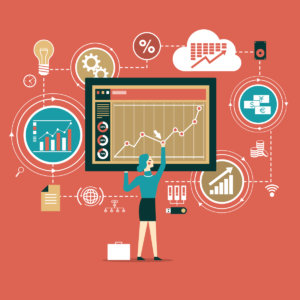Tomorrow’s KPI Dashboards Will Be Your Boss
As KPI dashboards evolve, they’re transforming how executives manage themselves.
Topics
Strategic Measurement
In Collaboration With
TCSLook at your watch: Does it just tell time, or can it also display how many steps you’ve taken? How about help you schedule texts and navigate city streets?
The same smartwatch technology that tracks heartbeat and calendars can also enable real-time display of the KPIs that effectively run your business. Digital device innovation enables “KPIs everywhere” — for example, “Alexa/Siri/Cortana, how does this week’s ARPU compare with last week’s?” Such mobile KPI platforms won’t just transform how we think about dashboards — they’ll transform leadership behavior.
However, as stated in our recent research report, “Leading With Next Generation Key Performance Indicators,” we were startled to find that only 45% of survey respondents can monitor KPIs on their smartphones. That seems unsustainable. Doing KPI “drill-downs” — that is, examining the KPIs’ underlying data components — on smartphones should be as simple and easy as booking a flight. Alexa, for example, should have the “skills” to respond to KPI update requests. The technologies exist, and the conceptual and technical ambitions for dashboards are growing. The most sophisticated KPI-driven organizations in our global executive survey say they constantly look for ways to get greater value and insight from their KPIs.
Expanding how people engage and interact with dashboards will expand how people engage and interact with KPIs. That’s powerful. As one contemporary definition puts it, “A dashboard is a visual display of the most important information needed to achieve one or more objectives, consolidated and arranged on a single screen so the information can be monitored at a glance.” But multimedia device innovation simultaneously extends and subverts that design ethos. Dashboard infographics have just begun to reflect and respect interactive potential.
As surely as innovation in automation and autonomy will reframe airplane and automobile dashboard design, machine learning and AI algorithms will reinvent how KPI dashboards can steer organizations. Dashboards are becoming smarter, more anticipatory, and more personalized. The visual remains vital, but it’s just one part of a KPI platform ecosystem.
The Netflix-ification of KPI Dashboards
The same techniques and technologies that have transformed video viewing will transform KPI engagement. KPI dashboards will be designed to explicitly learn about their users, make data-driven recommendations, and, yes, encourage KPI “binge-watching.” More than 60% of Netflix survey participants, for example, say they binge-watch regularly. What portion of senior management might KPI binge-watch in pursuit of better insights and decisions? When appropriately configured, KPIs — individually and collectively — become engaging content that analytically enlightens CFOs, CMOs, and boards. You can Netflix-ify dashboards by highlighting — or even animating — particular KPI sequences: Swipe left for KPIs that meet expectations; swipe right for those requiring further review; tap twice to replay the last 10 days of these KPIs. Feature engineering techniques and recommender system algorithms make this possible.
Continuous customization and personalization — not just content — is at the heart of Netflix’s success. Netflix assiduously tracks user interactions. A “view” describing a collection of events is created each time a subscriber starts watching a movie or TV episode. Netflix’s system gathers signals throughout each view to determine whether viewers are, in fact, watching the show. The system also tracks individual searches, ratings, geolocation data, device information, browsing behavior, time of day and week, when shows are abandoned, and when they pause or fast-forward.
Serious data-driven managers should want to know how they actually view and interact with their KPI dashboards. Instrumenting and networking the dashboard — à la Netflix — creates a wealth of value-added transformational opportunities.
Netflix-ified KPI data and metadata should similarly prove helpful in assessing how reliably managers monitor KPIs. Several flavors of KPI dashboard innovation not only become possible but desirable.
KPI Dashboards as Recommender Systems
Netflix’s views data powers the platform’s exceptionally successful recommendations. “Seventy-five percent of users select movies based on the company’s recommendations,” observes one senior Netflix data scientist, “and Netflix wants to make that number even higher.”
Technically, there’s no reason why recommender systems couldn’t similarly prioritize, personalize, and contextualize KPIs for executive attention: Executives who look at these Net Promoter Scores look at those customers; managers who monitor this strategic marketing KPI might be interested in viewing these functional financial KPIs; when this KPI decreases by more than 10% in a week, adjust expectations for those KPIs by 5% next month.
The purpose here isn’t to persuade users to sample new shows but to expose managers to novel KPI relationships they otherwise might have missed. Their dashboards learn over time to personalize and customize the most interesting and relevant KPI ensembles. How valuable might that be? Netflix-ified KPI dashboard recommenders succeed when managers and executives discover actionable insights that change minds and behaviors.
KPI Dashboards as ‘Nudges’
How might organizations help ensure their people use KPI dashboards effectively? Nobel Prize winning behavioral economics research suggests dashboards can be designed to “nudge” users into productively reviewing and responding to KPIs. That is, KPIs can be presented in ways that improve outcomes for both managers and the enterprise alike. Instead of simply displaying information, dashboards can prompt better behaviors.
“A nudge is any aspect of the choice architecture that alters people’s behavior in a predictable way without forbidding any options or significantly changing their economic incentives,” observe Harvard Law School professor Cass Sunstein and 2017 Nobel Laureate economist Richard Thaler in their 2008 book of the same title. “To count as a mere nudge, the intervention must be easy and cheap to avoid. Nudges are not mandates. Putting fruit at eye level counts as a nudge. Banning junk food does not.”
A KPI dashboard nudge might be a share button that makes sending a KPI — with a comment or annotation — easy, or a default that sends a time-stamped summary of all your KPI dashboard-related activity to your in-box at either day’s end or the beginning of the next workday, if that’s more effective. Encouraging constructive engagement with KPIs without overt coercion is the goal.
Critics and supporters of nudges often describe the concept as an example of libertarian paternalism — that is, individuals are nudged toward choices that are normatively in their best interest without actually limiting choice. That said, more command-and-control-oriented organizations might consider digital “shoves” to guarantee or enforce KPI compliance. Rising KPI ubiquity assures that choice architectures become dramatically more important for influencing managerial behavior. KPI dashboards become “decision cathedrals” for choice architects.
KPI Dashboards as Training and Education Platforms
KPIs are the essential metrics through which the organization holds itself accountable. Their underlying rationales can be complicated and their supporting data and algorithms complex. But gaining greater understanding and insight into KPIs can improve decision-making competence and confidence.
As KPIs and their underlying data coevolve, why not KPI wikis or FAQs to explain their dependencies? Tap a KPI and see the data sets that go into its creation. Tap again and get a YouTube-like tutorial on how that KPI is compiled and computed. Check the wiki or FAQ to learn what data quality issues hurt the KPI’s reliability. Curious about possible correlations between the organization’s Net Promoter Scores and its marketing KPIs? Post questions on the organization’s internal KPI Quora and see who answers.
HR staff, for example, cannot be presumed to understand why marketing leaders disproportionately emphasize one set of marketing KPIs over others. Similarly, sales teams may not understand the rationales for customer success team KPIs. Consequently, the ability to read, review, and even contribute to KPI wikis, FAQs, and Quoras can prove tremendously important to organizational collaboration and alignment. Serious HR departments would want to facilitate and encourage this. Promoting teamwork and onboarding new hires become easier when KPI dashboards become portals for training and professional development. Another desirable outcome: Ongoing digital tutorials and explanations become a dynamic source of KPI metadata for the enterprise.
KPI Dashboards as Early Warning Systems
One of our most significant survey findings was that KPIs are being used as much to anticipate and predict future performance as to retrospectively review past performance. Instead of helping managers and executives better analyze what went wrong, AI-enriched KPIs could alert leaders to potential problems and upcoming opportunities. At the simplest level, at-risk KPIs could flicker, change color, or otherwise call attention to themselves — texting to one’s phone, for example, saying, “You need to look at me as soon as possible.”
This analogizes to sophisticated airplane cockpits where human pilots not only passively monitor flight indicators but are proactively alerted when undesirable risks threaten — for example, commercial airliners descending at inappropriate rates or angles trigger acoustic “Pull up! Pull up!” cockpit warnings. For some cutting-edge aircraft, the automatic pilot literally takes over from the human one. Determining what risk levels justify such technical intervention increasingly shapes aviation safety debates.
Comparable circumstances and questions apply to commercial KPI dashboards: What deviations from performance expectations merit proactive alerts or outright intervention? At several companies we spoke with, notably GoDaddy and 1-800-Flowers, KPI dashboards directly tie into automated decisioning systems. As with airline cockpits, certain events or circumstances can trigger not just warnings but preprogrammed KPI-driven digital decisions. Note: These are done predictively — in anticipation of a business risk or scenario — not just in response to a bad event.
These systems can be opportunistic as well. Subtle shifts in KPIs may suggest that certain clients or customer segments are ripe for a sales approach or an upgrade offer. Again, the ongoing creation of predictive/anticipatory KPIs suggests that dashboard users will be spending more time marshaling resources for future action than past performance review.
KPI Dashboards as Communication Platforms
Another common theme and critical research survey finding was that sophisticated data-driven organizations promote greater transparency and alignment around KPIs. In effect, KPIs are used to communicate and coordinate enterprise expectations and actions. Yes, individual executives have their own KPI dashboards to manage their business, but effectively communicating those KPIs to colleagues and subordinates across the enterprise is essential to getting the job done.
KPI ubiquity makes communication around KPIs even more important. Indeed, KPI ubiquity is itself a form of communication — wherever people turn on their devices, KPIs are there. How best to communicate them with others? Should KPIs have their own Slack or Chatter channels? To what extent are key meetings built or organized around KPIs. The organization needs to be comfortable not just with the quality and timeliness of its KPIs but with the communication surrounding them.
Using KPI dashboards as conversational interfaces, enablers, and tools is essential as KPI ubiquity becomes a new normal. When someone’s smartwatch signals a balky KPI, that person needs to be able to immediately and appropriately share the signal.
KPI dashboard Netflix-ification can’t — and shouldn’t — be separate or distinct from the institutional imperative (or desire) to nudge, educate, or warn. The technological opportunities to get dramatically greater value from KPIs are there. Indeed, the opportunity to actually measure how organizations can get greater value from their KPIs is there as well.
But most important is remembering that KPI dashboards are a means to an end. The purpose is not to have better dashboards or more ubiquitous KPIs — it’s being able to convert greater KPI awareness and capability into greater business value. In essence, better dashboards should lead to better outcomes. That is the KPI that matters most.










Comments (2)
michael schrage
Productive Physician